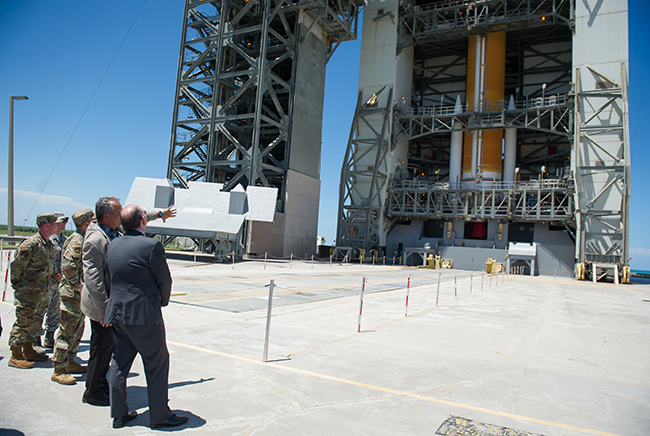
Acting Air Force Secretary Matthew Donovan is shown United Launch Alliance’s Delta IV rocket on Space Launch Complex-37 on July 19, 2019, at Cape Canaveral AFS, Fla. Air Force photo by Jared Trimarch.
Anticipating new space assets and the need to rapidly deploy space payloads, the Air Force is pressing to increase the frequency and speed with which it can launch satellites into orbit and then reset to prepare for more launches as quickly as possible.
The goal: 48 launches per year and the ability to launch on demand across the Eastern Range, which comprises the entire Atlantic Seaboard, said Brig. Gen. Douglas Schiess, commander of the 45th Space Wing at Patrick AFB, Fla., and director of the range.
As the officer responsible for all rocket launches from the Eastern Seaboard, Shiess is pressing to expand launch capacity and efficiency. After executing just seven launches in 2007, the low point for the Eastern Range, Patrick supported 24 launches in 2018 and could approach 30 this year.
“In August, we launched two payloads, on two different launch pads, within 34 hours,” Shiess told a Mitchell Institute for Aerospace Studies gathering Oct. 9. If necessary, the wing was prepared to compress that to just 10 hours, he said. “We may not be at 48 per year yet, but we’re on the way to having the training, the people, and the processes in place to make that happen.”
Being able to launch on demand, as military demands require, is also on tap. To get there, the base is defining modernization requirements and Gen. Jay Raymond’s Air Force Space Command is floating a vision for the “Range of the Future” to enable on-demand launches.
Schiess said that plan is envisioned as a common range architecture, and that it will ultimately grow from concept into a comprehensive program of record to be managed by the Air Force Space and Missile Center. Defining a standard architecture, he said, will enable the Air Force to establish shared protocols at both Eastern and Western ranges, and common systems so that providers have a standard interface for connecting their unique systems.
“We need to be able to have the minimum essential infrastructure to be able to launch from either the Eastern or Western Ranges, but [also support] an individual launch provider that may need something different,” Schiess explained. “So instead of us spending a lot of money to provide that for them, let’s provide an infrastructure into which they can plug and play, so they can bring whatever they need or want for their specific launch.”
The primary need right now is a modernized data and communications backbone. “We’re in the process of doing that now,” Schiess said. “Right now, it’s not quite a telephone operator moving one patch to another, but it’s close. The ability to digitally redo the range, so you can say now I’m using this telemetry instead of the other one for a launch.” Putting telemetry on vans, as opposed to at fixed locations, would allow the base more options for rapid, changing launch plans. Patrick is also upgrading power and water lines to support launches.
But perhaps the biggest change is cultural, he said. In the past, he said, “We were cocked to say, ‘No, we’re not ready to launch today,’ or ‘No, this is not ready.’ Now that atmosphere has changed to ‘Why aren’t we? What do we need to get to yes’ ”
Indeed, that attitude is what made August’s two launches in two days possible. “That was a bunch of people getting together and saying, ‘How can we get to yes’ ”
